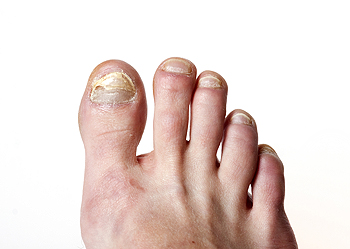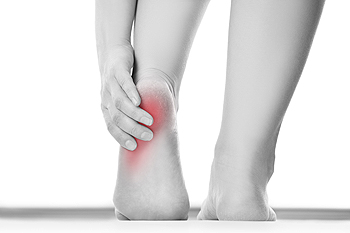Items filtered by date: September 2021
Who Should I See To Treat Toenail Fungus?
 Your podiatrist can help you take care of not only your feet and ankles, but also your toenails. One very common condition that podiatrists treat are fungal toenail infections. These infections often start as athlete’s foot, a skin infection, before spreading to the toenails, although they can also occur on just the nails. Symptoms of toenail fungus include changes in the texture, color, and shape of the nail. The nail may become crumbly, brittle, or thickened and develop yellow, white, or brown spots. In more severe cases, the nail can change shape, separate from the nail bed, emit a foul odor, and make wearing shoes uncomfortable. If you have toenail fungus, and particularly if you have toenail fungus and diabetes, it is suggested that you see a podiatrist for treatment.
Your podiatrist can help you take care of not only your feet and ankles, but also your toenails. One very common condition that podiatrists treat are fungal toenail infections. These infections often start as athlete’s foot, a skin infection, before spreading to the toenails, although they can also occur on just the nails. Symptoms of toenail fungus include changes in the texture, color, and shape of the nail. The nail may become crumbly, brittle, or thickened and develop yellow, white, or brown spots. In more severe cases, the nail can change shape, separate from the nail bed, emit a foul odor, and make wearing shoes uncomfortable. If you have toenail fungus, and particularly if you have toenail fungus and diabetes, it is suggested that you see a podiatrist for treatment.
For more information about treatment, contact Dr. Michael A. Wood of Foot Health Institute. Our doctor can provide the care you need to keep you pain-free and on your feet.
Toenail Fungus Treatment
Toenail fungus is a condition that affects many people and can be especially hard to get rid of. Fortunately, there are several methods to go about treating and avoiding it.
Antifungals & Deterrence
Oral antifungal medicine has been shown to be effective in many cases. It is important to consult with a podiatrist to determine the proper regiment for you, or potentially explore other options.
Applying foot powder on the feet and shoes helps keep the feet free of moisture and sweat.
Sandals or open toed shoes – Wearing these will allow air movement and help keep feet dry. They also expose your feet to light, which fungus cannot tolerate. Socks with moisture wicking material also help as well.
If you have any questions please feel free to contact one of our offices located in Lansing, and Chicago, IL . We offer the newest diagnostic tools and technology to treat your foot and ankle needs.
Why Am I Experiencing Pain in My Heel?
If you experience pain in your heel once you take the first few steps after a period of rest or sleep, you may have plantar fasciitis. Plantar fasciitis is one of the most common forms of heel pain. It occurs when the long ligament on the bottom of your feet (the plantar fascia) that connects your heel with your toes becomes overly stressed, torn, or otherwise damaged. The pain may be stabbing or throbbing and the area may be inflamed. Plantar fasciitis may even be linked or occur in tandem with heel spurs—which are bony growths that form where the plantar fascia attaches to the heel bone. If you have pain in your heel that tends to be worse after periods of rest, make an appointment with a podiatrist for a full examination, diagnosis, and treatment.
Many people suffer from bouts of heel pain. For more information, contact Dr. Michael A. Wood of Foot Health Institute. Our doctor can provide the care you need to keep you pain-free and on your feet.
Causes of Heel Pain
Heel pain is often associated with plantar fasciitis. The plantar fascia is a band of tissues that extends along the bottom of the foot. A rip or tear in this ligament can cause inflammation of the tissue.
Achilles tendonitis is another cause of heel pain. Inflammation of the Achilles tendon will cause pain from fractures and muscle tearing. Lack of flexibility is also another symptom.
Heel spurs are another cause of pain. When the tissues of the plantar fascia undergo a great deal of stress, it can lead to ligament separation from the heel bone, causing heel spurs.
Why Might Heel Pain Occur?
- Wearing ill-fitting shoes
- Wearing non-supportive shoes
- Weight change
- Excessive running
Treatments
Heel pain should be treated as soon as possible for immediate results. Keeping your feet in a stress-free environment will help. If you suffer from Achilles tendonitis or plantar fasciitis, applying ice will reduce the swelling. Stretching before an exercise like running will help the muscles. Using all these tips will help make heel pain a condition of the past.
If you have any questions please contact one of our offices located in Lansing, and Chicago, IL . We offer the newest diagnostic and treatment technologies for all your foot and ankle needs.
Rest and Stretching May Help Sever’s Disease
Children who enjoy participating in running and jumping activities may be more prone to developing a foot condition that is known as Sever’s disease. Young athletes can suffer from this painful foot condition that affects the heel. Sever's disease occurs as a result of an inflammation that affects the growth plate in the heel, and typically targets children between the ages of nine and twelve. Additionally, it may come from wearing shoes that do not fit correctly, which can put stress on the heel. Children often limp when this condition is present, and physical activity may have to stop as the healing process occurs. There are specific stretches that can be performed which may help to diminish existing pain and discomfort, in addition to possibly accelerating healing. If you notice your child is limping due to heel pain, please consult with a podiatrist who can properly diagnose and treat Sever's disease.
Sever's disease often occurs in children and teens. If your child is experiencing foot or ankle pain, see Dr. Michael A. Wood from Foot Health Institute. Our doctor can treat your child’s foot and ankle needs.
Sever’s Disease
Sever’s disease is also known as calcaneal apophysitis, which is a medical condition that causes heel pain I none or both feet. The disease is known to affect children between the ages of 8 and 14.
Sever’s disease occurs when part of the child’s heel known as the growth plate (calcaneal epiphysis) is attached to the Achilles tendon. This area can suffer injury when the muscles and tendons of the growing foot do not keep pace with bone growth. Therefore, the constant pain which one experiences at the back of the heel will make the child unable to put any weight on the heel. The child is then forced to walk on their toes.
Symptoms
Acute pain – Pain associated with Sever’s disease is usually felt in the heel when the child engages in physical activity such as walking, jumping and or running.
Highly active – Children who are very active are among the most susceptible in experiencing Sever’s disease, because of the stress and tension placed on their feet.
If you have any questions, please feel free to contact one of our offices located in Lansing, and Chicago, IL . We offer the newest diagnostic and treatment technologies for all your foot and ankle injuries.
Why Live with Pain and Numbness in Your Feet?
Obesity Can Make Foot Problems More Likely
 Obesity can affect many parts of the body - and the feet are no exception. Obesity, defined as a body mass index (BMI) of 30 or more, is a threat to the health of your feet. People who are obese are at an increased risk of foot problems, including plantar fasciitis, Achilles tendonitis, and arthritis, because of the pressure that excess body weight puts on the muscles, ligaments, and joints of the feet and ankles. People who are obese are also at an increased risk of developing type II diabetes, a systemic condition that can lead to poor circulation, nerve damage, and poorly healing wounds in the lower limbs. If you are overweight or obese and suffering from foot pain, seeing a podiatrist can help you get the care you need.
Obesity can affect many parts of the body - and the feet are no exception. Obesity, defined as a body mass index (BMI) of 30 or more, is a threat to the health of your feet. People who are obese are at an increased risk of foot problems, including plantar fasciitis, Achilles tendonitis, and arthritis, because of the pressure that excess body weight puts on the muscles, ligaments, and joints of the feet and ankles. People who are obese are also at an increased risk of developing type II diabetes, a systemic condition that can lead to poor circulation, nerve damage, and poorly healing wounds in the lower limbs. If you are overweight or obese and suffering from foot pain, seeing a podiatrist can help you get the care you need.
The more you weigh, the harder your feet must work to support your body. If you’re an obese individual and are concerned about your feet, contact Dr. Michael A. Wood from Foot Health Institute. Our doctor can provide the care you need to keep you pain-free and on your feet.
Obesity and Your Feet
People who are overweight are putting more pressure on their ankles, knees, and hips as well as their feet. This unfortunately can lead to variety of different issues.
Problems & Complications Stemming from Obesity
- When the body is overweight, it tries to compensate by changing the way that it moves. An obese person may lean forward and put extra weight on the wrong part of the foot. This puts unnecessary stress on the feet.
- Obese people are also more likely to develop type II diabetes which is a condition that causes a lot of foot problems. People with diabetes often don’t feel the cuts and sores that they may have on their feet, which can lead to more complicated and severe issues.
- Plantar fasciitis is another foot condition that can be caused by obesity. Plantar fasciitis is an inflammation of the tissue along the bottom of the foot, which causes pain and stiffness while walking and climbing stairs.
If you have any questions, please feel free to contact one of our offices located in Lansing, and Chicago, IL . We offer the newest diagnostic and treatment technologies for all your foot care needs.


